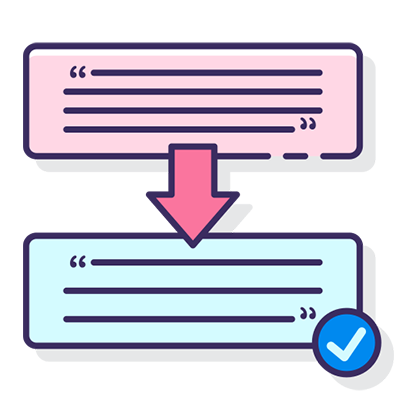
Worksheets & References
This feeling, finally, that we may change things – this is at the center of everything we are. Lose that… lose everything.
– Sir David Hare
Although this course is coming to a close, we hope that your journey to improve your business writing skills is just beginning. Please take a moment to review and update your action plan. This will be a key tool to guide your progress in the days, weeks, months, and years to come. We wish you the best of luck on the rest of your travels!
Worksheet One: Parts of Sentences
Which among the following statements are not complete sentences?
REMEMBER: Complete sentences have a subject and a predicate.

- She walks.
- Considering that the market value of the property is up 10 percent.
- Which was a very risky thing to do.
- The memo was delivered to the Human Resource Officer.
- The production manager who was trained in New Jersey.

Worksheet Two: Types of Sentences
Classify the following statements as declarative, interrogative, imperative, and exclamatory.
1) The team discussed the feasibility of the new proposal.
2) I am willing to meet you at your most convenient time.
3) Submit all forms at counter C.
4) Was the memo sent to the appropriate authority?
5) Kindly inform me of any changes in the schedule.
6) I needed that presentation yesterday!
7) Who is in charge of daily operations?
8) We need to fill this position ASAP!
9) Take the 4A bus from Middleton and unload at Carper St.
10) At the end of the year, we are expecting to double our sales figures.
Worksheet Three: Organizing Paragraphs
Create an outline of a 5-paragraph discussion on “Why the Company Should Start Saving on Electricity.”
TITLE: “Why the Company Should Start Saving on Electricity.”
Paragraph 1 Topic: ______________________________________________
Paragraph 2 Topic: ______________________________________________
Paragraph 3 Topic: ______________________________________________
Paragraph 4 Topic: ______________________________________________
Paragraph 5 Topic: ______________________________________________
What is your basis for the topics you’ve chosen?
What is your basis for arranging the paragraphs the way you did?
Worksheet Four: Writing Agendas
AGENDA
TITLE OF THE MEETING
ORGANIZATION NAME
Date:
Place:
Estimated Start Time:
Estimated Ending Time:
Purpose of the Meeting:
Invited (or Confirmed) Attendees:
1
2
3
4
5
6
Advanced Preparation Reminders:
Worksheet Five: Basic Structure of Emails
- Study the following email and answer the guide questions below:
Dear John,
SUM1 sent a proposal thru fax yet. Look at it, IMO it’s very good. seems 2 know what we’re looking 4. Pls. Let m know what u THINK over the wknd. 🙂
Peter
What impressions do you get from the email above?
Rank the email on a scale of 1 to 5 based on the following criteria, with 1 being the lowest and 5 the highest.
Readability 1 2 3 4 5
Clarity of Message 1 2 3 4 5
Professionalism 1 2 3 4 5
- Now, consider this email:
Dear John,
I received a project proposal via fax yesterday. Could you take a look at it? I’ve read it and it seems very good. Looks like what we’re looking for. If it’s possible, could you please let me know what you think over the weekend?
Peter
What impressions do you get from the email above?
Rate the above email based on the following criteria, with 1 as the lowest and 5 as the highest.
Readability 1 2 3 4 5
Clarity of Message 1 2 3 4 5
Professionalism 1 2 3 4 5
Readability 1 2 3 4 5
Clarity of Message 1 2 3 4 5
Professionalism 1 2 3 4 5
Which email do you prefer? Why?
Answers
Worksheet One: Parts of Sentences
- YES
- YES
- NO
- YES
- YES
Worksheet Two: Types of Sentences
1) Declarative
1) Declarative
3) Imperative
4) Interrogative
5) Declarative
6) Exclamatory
7) Interrogative
8) Exclamatory
9) Imperative
10) Declarative
References
Abell, A. (2003). Business Grammar, Style and Usage. Aspatore, Inc.
Blake, G. & Bly, R.W. (1992). The Elements of Business Writing: A Guide to Writing Clear, Concise Letters, Memos, Reports, Proposals, and other business Documents. Longman.
Forsyth, P. (2006). How to Write Reports and Proposals (Creating Success). Kogan Page.
Sant, Tom (2003). Persuasive Business Proposals: Writing to Win More Customers, Clients, and Contracts. AMACOM.






